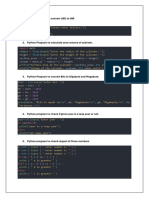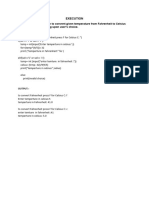0 ratings0% found this document useful (0 votes)
38 viewsPython Lab Bhavya
The document describes 7 Python programming experiments involving taking command line arguments, matrix multiplication, GCD calculation, finding most frequent words in a text file, calculating square roots using Newton's method, exponentiation, and finding the maximum of a list.
Uploaded by
bhavya12mittalCopyright
© © All Rights Reserved
Available Formats
Download as PDF, TXT or read online on Scribd
0 ratings0% found this document useful (0 votes)
38 viewsPython Lab Bhavya
The document describes 7 Python programming experiments involving taking command line arguments, matrix multiplication, GCD calculation, finding most frequent words in a text file, calculating square roots using Newton's method, exponentiation, and finding the maximum of a list.
Uploaded by
bhavya12mittalCopyright
© © All Rights Reserved
Available Formats
Download as PDF, TXT or read online on Scribd
You are on page 1/ 7
EXPERIMENT-1
Write a python program that takes in command line arguments as
input and print the number of arguments.
Code:
import sys
# Get the command line arguments (excluding the
script name)
arguments = sys.argv[1:]
# Print the number of arguments
print("Number of arguments: “,len(arguments))
Output:
Bhavya Mittal (2100910100058)
EXPERIMENT-2
Write a python program to perform matrix multiplication.
Code:
matrix1 = [[1, 2, 3], [4, 5, 6]]
matrix2 = [[7, 8], [9, 10], [11, 12]]
# Perform matrix multiplication
result_rows = len(matrix1)
result_cols = len(matrix2[0])
result = []
for i in range(result_rows):
result.append([0]*result_cols)
for i in range(len(matrix1)):
for j in range(len(matrix2[0])):
for k in range(len(matrix2)):
result[i][j] += matrix1[i][k] * matrix2[k][j]
# Print the result
print("Matrix 1:")
for row in matrix1:
print(row)
print("Matrix 2:")
for row in matrix2:
print(row)
print("Result:")
for row in result:
print(row)
Output:
Bhavya Mittal (2100910100058)
EXPERIMENT-3
Write a python program to compute GCD of two numbers.
Code:
num1 = 36
num2 = 48
# Compute GCD
gcd = 1
for i in range(1, min(num1, num2) + 1):
if num1 % i == 0 and num2 % i == 0:
gcd = i
# Print the result
print(f"The GCD of “,num1,” and “,num2,” is: “,gcd)
Output:
Bhavya Mittal (2100910100058)
EXPERIMENT-4
Write a python program to find more frequent word in a text file.
Code:
file_path = input("Enter the text file to read : ")
word_count = {}
with open(file_path, 'r') as file:
for line in file:
words = line.strip().split()
for word in words:
if word in word_count:
word_count[word] += 1
else:
word_count[word] = 1
most_frequent_word = None
max_count = 0
for word, count in word_count.items():
if count > max_count:
most_frequent_word = word
max_count = count
# Print the result
print("Most frequent word:", most_frequent_word)
Output:
Bhavya Mittal (2100910100058)
EXPERIMENT-5
Write a python program to find square root of a number (using
Newton’s Method)
Code:
number = int(input("Enter a number : "))
# Find the square root
result_sqrt = number / 2 # Initial guess
precision = 0.001
while abs(result_sqrt**2 - number) > precision:
result_sqrt = (result_sqrt + number / result_sqrt) /
2
# Print the result
print("Square root of", number, "is:", result_sqrt)
Output:
Bhavya Mittal (2100910100058)
EXPERIMENT-6
Write a python program for exponentiation (power of a number).
Code:
a = int(input("Enter the value of A : "))
n = int(input("Enter the value of N : "))
r = a**n
print(a," to power ", n, "equals to ", r)
Output:
Bhavya Mittal (2100910100058)
EXPERIMENT-7
Write a python program to find the maximum of a list of numbers.
Code:
user_list = eval(input("Enter the list of numbers : "))
max_number = 0
for i in user_list:
if i > max_number:
max_number = i
print("Maximum number : ", max_number)
Output:
Bhavya Mittal (2100910100058)
You might also like
- Cheat Code Booklet For Alevel P4-Python NewNo ratings yetCheat Code Booklet For Alevel P4-Python New69 pages
- Practical 3 Aiml: Done by Anish: T20012531007No ratings yetPractical 3 Aiml: Done by Anish: T2001253100739 pages
- II Term Std 10 - Revision 5 for Robotics & AINo ratings yetII Term Std 10 - Revision 5 for Robotics & AI19 pages
- Python Lab Programs 1. To Write A Python Program To Find GCD of Two NumbersNo ratings yetPython Lab Programs 1. To Write A Python Program To Find GCD of Two Numbers12 pages
- Lab File: Department of Computer Science & EngineeringNo ratings yetLab File: Department of Computer Science & Engineering24 pages
- Python Programming Practical No 16to 30No ratings yetPython Programming Practical No 16to 3081 pages
- Python_Lab Manual for University StudentNo ratings yetPython_Lab Manual for University Student19 pages
- Asynchronous Programming in C# and Visual Basic: Mads Torgersen, Microsoft October 2010No ratings yetAsynchronous Programming in C# and Visual Basic: Mads Torgersen, Microsoft October 201015 pages
- Car Renting Management System Proposal PDFNo ratings yetCar Renting Management System Proposal PDF3 pages
- sapnote-205528_Report painter_ILLEGAL_SIGN_FORMATNo ratings yetsapnote-205528_Report painter_ILLEGAL_SIGN_FORMAT2 pages
- Conditional Control Structure Chap - 04 - Class - 10No ratings yetConditional Control Structure Chap - 04 - Class - 1018 pages
- Worksheet - Compound Conditionals: Chained and Nested ConditionalsNo ratings yetWorksheet - Compound Conditionals: Chained and Nested Conditionals5 pages
- Coffee Shop Management System Documentation-FinalNo ratings yetCoffee Shop Management System Documentation-Final43 pages
- Troubleshooting Note For SAP HANA Platform Lifecycle Management Tool HDBLCMNo ratings yetTroubleshooting Note For SAP HANA Platform Lifecycle Management Tool HDBLCM9 pages
- Welcome To Java Programming Course at Seed: SEED Infotech Pvt. LTDNo ratings yetWelcome To Java Programming Course at Seed: SEED Infotech Pvt. LTD36 pages
- Incremental Compilation in The Vcs EnvironmentNo ratings yetIncremental Compilation in The Vcs Environment6 pages
- History of The Java™ Programming LanguageNo ratings yetHistory of The Java™ Programming Language6 pages
- Python Lab Programs 1. To Write A Python Program To Find GCD of Two NumbersPython Lab Programs 1. To Write A Python Program To Find GCD of Two Numbers
- Lab File: Department of Computer Science & EngineeringLab File: Department of Computer Science & Engineering
- Asynchronous Programming in C# and Visual Basic: Mads Torgersen, Microsoft October 2010Asynchronous Programming in C# and Visual Basic: Mads Torgersen, Microsoft October 2010
- Conditional Control Structure Chap - 04 - Class - 10Conditional Control Structure Chap - 04 - Class - 10
- Worksheet - Compound Conditionals: Chained and Nested ConditionalsWorksheet - Compound Conditionals: Chained and Nested Conditionals
- Troubleshooting Note For SAP HANA Platform Lifecycle Management Tool HDBLCMTroubleshooting Note For SAP HANA Platform Lifecycle Management Tool HDBLCM
- Welcome To Java Programming Course at Seed: SEED Infotech Pvt. LTDWelcome To Java Programming Course at Seed: SEED Infotech Pvt. LTD

























































































